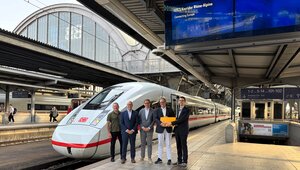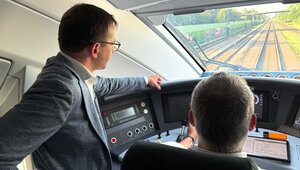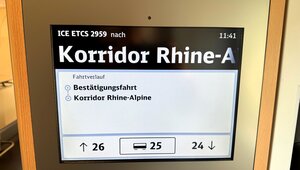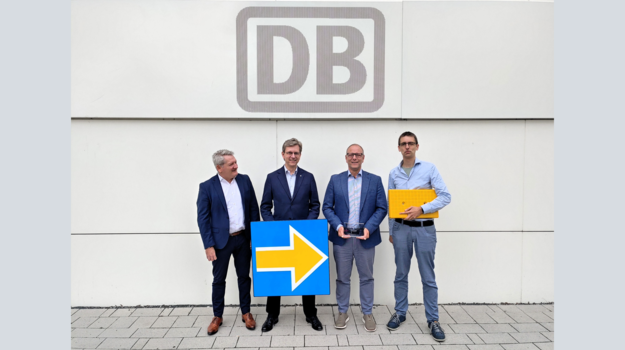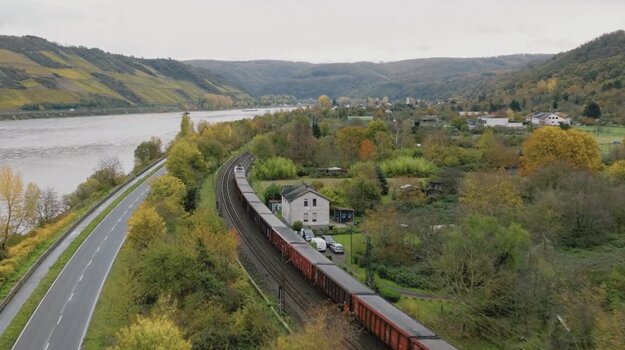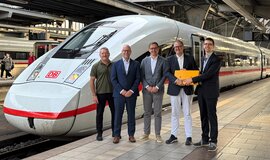
100 kilometers of ETCS on the Corridor Rhine-Alpine in practical testing – confirmation train ride with ETCS Level 2 between Freiburg and Basel
Representatives from DB InfraGO AG, including CEO Dr. Philipp Nagl, and Hitachi Rail in Germany, including Managing Director Markus Fritz, had a special trip on the agenda on August 14. At 8:28 a.m. sharp, an ICE 4 train equipped with the train control system ETCS Level 2 (L2) departed from Karlsruhe bound for the Swiss border station of Basel Badischer Bahnhof. Just last weekend, ETCS L2 was fully commissioned on a 100-kilometer section of the Rhine Valley Railway – a central section of the Rhine-Alpine corridor. The representatives were impressed by the digitized route.
With the commissioning of Hitachi Rail's three Radio Block Centers (RBC) in Freiburg, Buggingen, and Basel, ETCS L2 was also fully commissioned on the night of August 9 to 10 on approximately 100 kilometers of the Rhine-Alpine corridor between Gundelfingen (north of Freiburg) and Haltingen (Swiss border near Basel). This marks the first time that ETCS L2 has been used in Germany in combination with the national train control systems Punktförmige Zugbeeinflussung (PZB) and Linienförmige Zugbeeinflussung (LZB). This means that several train control systems are currently working hand in hand on the route between Freiburg and Basel. This combination allows for a gradual migration to ETCS: vehicle owners and railway companies can gradually convert their vehicles to ETCS without having to interrupt operations.

Ulrich Kohlenberger, Head of the Rhine-Alpine Corridor Project: "The successful commissioning of Hitachi Rail's first Radio Block Center in Germany is a significant milestone for the further implementation of ETCS Level 2 in Germany. For the first time, it is being implemented in parallel with the national train control systems Punktförmige Zugbeeinflussung (PZB) and Linienförmige Zugbeeinflussung (LZB). This means that trains that are not yet equipped with ETCS can continue to run on the line. The new digital technology is an important contribution to an efficient, future-proof, and interoperable infrastructure. This brings us another step closer to our goal of a modern and reliable rail system. I would like to thank the entire team that made this success possible."
On Thursday, August 14, 2025, high-ranking representatives from DB InfraGO AG and Hitachi Rail saw this impressive milestone for themselves, which forms the basis for further projects in the comprehensive ETCS rollout in Germany. During a confirmation train ride, the correct functioning of the newly commissioned track equipment with ETCS L2 was verified. This includes communication between the new RBC and the train, as well as the proper switching of the train between the new ETCS train control system and the national PZB and LZB train control systems throughout the entire journey. Representatives of DB InfraGO AG were on board the train, including Dr. Philipp Nagl (CEO), Ulrich Kohlenberger (Head of the Rhine-Alpine Corridor Project), Andreas Winter (Head of the Southwest Rhine-Alpine Corridor sub-project with POS Nord), and Wilko Eisele (Head of ETCS Commissioning Control – Rhine-Alpine Corridor). They were accompanied by representatives from Hitachi Rail in Germany, including Markus Fritz (Managing Director) and two members of the project management team, Frank Hehl and Michael Zills.
The journey began early in the morning at Karlsruhe station. Initially, the train was monitored by the national train control systems PZB and LZB. This meant that the train started in Karlsruhe with PZB before switching to LZB shortly before Baden-Baden. Shortly before Freiburg, the decisive section began: the train passed the first ETCS balises. These prompted it to register by radio with the first RBC to be passed in Freiburg. After successful registration, the train driver confirmed the change of train control systems: from that point on, ETCS took over monitoring of the journey. A special moment.
During the rest of the journey, there were two further changes to the two other new RBC in Buggingen and Basel. Technically, these so-called system changes are highly complex. For the train driver, however, this happens automatically and almost invisibly in the background. Passengers also do not notice anything during regular passenger service. South of Freiburg, the transition from the Freiburg RBC to the Buggingen RBC took place. Later – behind the Katzenberg tunnel – the transition to the RBC in Basel took place. At the end of the journey, shortly before Basel Badischer station, the train logged out of ETCS monitoring. From this point on, PZB took over again for the last few kilometers to the stop Basel Badischer station.
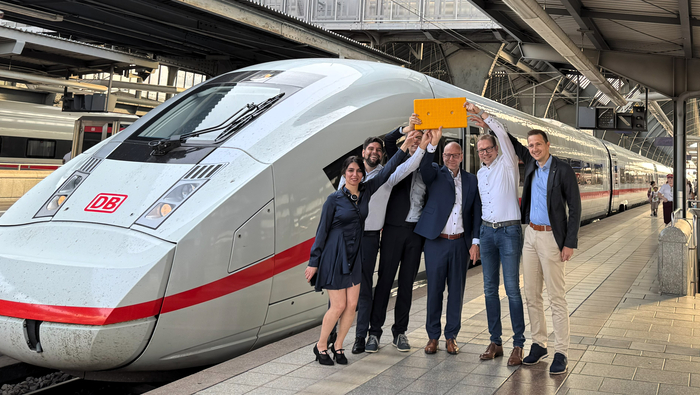
The journey was a complete success – the transitions between the three train control systems worked smoothly. This marks another important step in the ETCS rollout on the German section of the Rhine-Alpine corridor.

Markus Fritz, Managing Director of Hitachi Rail GTS Germany: "With today's ETCS Level 2 confirmation runs, we, #TeamHitachi, together with our customer and partner Deutsche Bahn, have set another real milestone for the digitalization of the rail network in Germany and Europe. This marks a decisive step into a new era of train control in our country's rail system. The three Radio Block Centers now in operation in Freiburg, Buggingen, and Basel not only form the technological basis for the Stuttgart Digital Node, they also mark the beginning of complete ETCS Level 2 equipment for the entire Rhine-Alpine corridor, which is of trans-European importance and will become even more efficient and reliable as a result. This brings us a decisive step closer to the mobility transition in Germany."
You can also find this post on LinkedIn.
